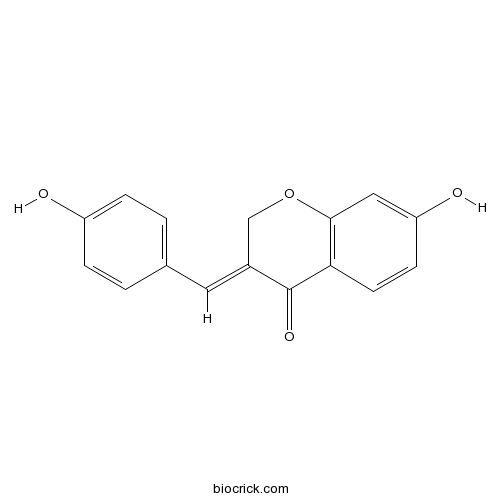7-Hydroxy-3-(4-hydroxybenzylidene)chroman-4-oneCAS# 110064-50-1 |

Quality Control & MSDS
3D structure
Package In Stock
Number of papers citing our products

| Cas No. | 110064-50-1 | SDF | Download SDF |
| PubChem ID | 44443280 | Appearance | Yellow powder |
| Formula | C16H12O4 | M.Wt | 268.3 |
| Type of Compound | Flavonoids | Storage | Desiccate at -20°C |
| Solubility | Soluble in Chloroform,Dichloromethane,Ethyl Acetate,DMSO,Acetone,etc. | ||
| Chemical Name | (3E)-7-hydroxy-3-[(4-hydroxyphenyl)methylidene]chromen-4-one | ||
| SMILES | C1C(=CC2=CC=C(C=C2)O)C(=O)C3=C(O1)C=C(C=C3)O | ||
| Standard InChIKey | CWFKSHWAQPOKQP-YRNVUSSQSA-N | ||
| General tips | For obtaining a higher solubility , please warm the tube at 37 ℃ and shake it in the ultrasonic bath for a while.Stock solution can be stored below -20℃ for several months. We recommend that you prepare and use the solution on the same day. However, if the test schedule requires, the stock solutions can be prepared in advance, and the stock solution must be sealed and stored below -20℃. In general, the stock solution can be kept for several months. Before use, we recommend that you leave the vial at room temperature for at least an hour before opening it. |
||
| About Packaging | 1. The packaging of the product may be reversed during transportation, cause the high purity compounds to adhere to the neck or cap of the vial.Take the vail out of its packaging and shake gently until the compounds fall to the bottom of the vial. 2. For liquid products, please centrifuge at 500xg to gather the liquid to the bottom of the vial. 3. Try to avoid loss or contamination during the experiment. |
||
| Shipping Condition | Packaging according to customer requirements(5mg, 10mg, 20mg and more). Ship via FedEx, DHL, UPS, EMS or other couriers with RT, or blue ice upon request. | ||
| Description | 7-Hydroxy-3-(4'-hydroxybenzylidene)-chroman-4-one may have anti-inflammatory activity. |
| Structure Identification | Chinese Journal of Experimental Traditional Medical Formulae, 2014 , 20 (20) :110-113.Chemical Constituents of Anti-in Flammatory Fraction of Caesalpinia decapetala[Reference: WebLink]To study the chemical constituents of the anti-inflammatory fraction of Caesalpinia decapetala. Method: The compounds were isolated and purified by silica gel and Sephadex LH-20 column chromatography and their structures were determined by chemical evidence and pectral analysis. Result: Nine compounds were obtained from C. decapetala and they were identified as( ±) protosappanin B( 1),scopoletin-7-O-β-D-glucopyranoside( 2),4-hydroxy-3-methoxypheny-1-O-β-D-glucopyranoside( 3),( 1' R,3' S,5' R,8' S,2Z,4E)-dihydrophaseic acid-3'-O-β-D-glucopyranoside( 4),( 1'R,3'S,5'R,8'S,2E,4E)-dihydrophaseic acid-3'-O-β-D-glucopyranoside( 5), liquiritigenin( 6), isoscopoletin( 7), 7-hydroxy-3-( 4'-hydroxybenzylidene)-chroman-4-one( 8),3-deoxysappanchalcone( 9). Conclusion: Compounds 2-5,7 were isolatedfrom thegenus C. for the firs time,and compounds 6,8 were obtained from the C. decapetala for the first time. |

7-Hydroxy-3-(4-hydroxybenzylidene)chroman-4-one Dilution Calculator

7-Hydroxy-3-(4-hydroxybenzylidene)chroman-4-one Molarity Calculator
| 1 mg | 5 mg | 10 mg | 20 mg | 25 mg | |
| 1 mM | 3.7272 mL | 18.6359 mL | 37.2717 mL | 74.5434 mL | 93.1793 mL |
| 5 mM | 0.7454 mL | 3.7272 mL | 7.4543 mL | 14.9087 mL | 18.6359 mL |
| 10 mM | 0.3727 mL | 1.8636 mL | 3.7272 mL | 7.4543 mL | 9.3179 mL |
| 50 mM | 0.0745 mL | 0.3727 mL | 0.7454 mL | 1.4909 mL | 1.8636 mL |
| 100 mM | 0.0373 mL | 0.1864 mL | 0.3727 mL | 0.7454 mL | 0.9318 mL |
| * Note: If you are in the process of experiment, it's necessary to make the dilution ratios of the samples. The dilution data above is only for reference. Normally, it's can get a better solubility within lower of Concentrations. | |||||

Calcutta University

University of Minnesota

University of Maryland School of Medicine

University of Illinois at Chicago

The Ohio State University

University of Zurich

Harvard University

Colorado State University

Auburn University

Yale University

Worcester Polytechnic Institute

Washington State University

Stanford University

University of Leipzig

Universidade da Beira Interior

The Institute of Cancer Research

Heidelberg University

University of Amsterdam

University of Auckland

TsingHua University

The University of Michigan

Miami University

DRURY University

Jilin University

Fudan University

Wuhan University

Sun Yat-sen University

Universite de Paris

Deemed University

Auckland University

The University of Tokyo

Korea University
- Strophantin K (mixture)
Catalog No.:BCC8256
CAS No.:11005-63-3
- Calpain Inhibitor I, ALLN
Catalog No.:BCC1233
CAS No.:110044-82-1
- Tussilagonone
Catalog No.:BCC8365
CAS No.:110042-38-1
- Taurohyodeoxycholic Acid Sodium Salt
Catalog No.:BCC8363
CAS No.:110026-03-4
- 8-O-Ethylyunaconitine
Catalog No.:BCN6260
CAS No.:110011-77-3
- Sorbic acid
Catalog No.:BCN2218
CAS No.:110-44-1
- Fumaric acid
Catalog No.:BCN5989
CAS No.:110-17-8
- Maleic acid
Catalog No.:BCN8426
CAS No.:110-16-7
- Succinic acid
Catalog No.:BCN5890
CAS No.:110-15-6
- ITD 1
Catalog No.:BCC6409
CAS No.:1099644-42-4
- Kifunensine
Catalog No.:BCC7601
CAS No.:109944-15-2
- Sodium prasterone sulfate
Catalog No.:BCC9149
CAS No.:1099-87-2
- 12-Epinapelline
Catalog No.:BCN2800
CAS No.:110064-71-6
- Plerixafor (AMD3100)
Catalog No.:BCC1158
CAS No.:110078-46-1
- des-His1-[Glu9]-Glucagon (1-29) amide
Catalog No.:BCC5885
CAS No.:110084-95-2
- Ascomycin
Catalog No.:BCN8286
CAS No.:11011-38-4
- Indoximod (NLG-8189)
Catalog No.:BCC5584
CAS No.:110117-83-4
- Methyl hesperidin
Catalog No.:BCN6341
CAS No.:11013-97-1
- 4-Galloylquinic acid
Catalog No.:BCN3733
CAS No.:110170-37-1
- Ouabain Octahydrate
Catalog No.:BCC5211
CAS No.:11018-89-6
- JZL184
Catalog No.:BCC4790
CAS No.:1101854-58-3
- 1,5,8-Trihydroxy-3-methoxy-2-prenylxanthone
Catalog No.:BCN1623
CAS No.:110187-11-6
- Malonylginsenoside Rb(1)
Catalog No.:BCC9230
CAS No.:88140-34-5
- Cochliophilin A
Catalog No.:BCC8154
CAS No.:110204-45-0
[Phenolic compounds from Caesalpinia minax].[Pubmed:23847948]
Zhongguo Zhong Yao Za Zhi. 2013 Apr;38(7):1014-7.
Fifteen compounds were obtained from the twigs and leaves of Caesalpinia minax. Their structures were identified as apigenin (1), 5,7,3',4'- tetrahydroxy-3-methoxyflavone (2), luteolin-5, 3 '-dimethyl-ether (3), thevetiaflavon (4), apigenin-7-O-beta-D-glucuronide (5), bonducellin (6), 7-hydroxy-3-( 4-hydroxybenzylidene )-chroman-4-one (7), 3-deoxysappanchalcone (8), 5-acetonyl-7-hydroxy-2-methyl chromone (9), 4-(trans)-acetyl-3,6,8-trihydroxy-3-methyl-dihydronaphthalenone (10), 4-(cis)-acetyl-3,6,8-trihydroxy-3-methyl-dihydronaphthalenone (11), vanillic acid (12), omega-hydroxypropioquaiacone (13), syringaresinol (14) and uracil (15). All compounds were isolated from C. minax for the first time. Compounds 1-14 were phenolic compounds and compounds 1-5, 9-13 and 15 were isolated from the genus Caesalpinia for the first time.


